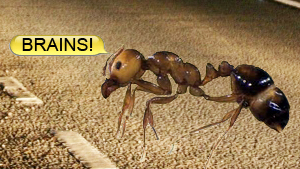Parasites are ubiquitous. I remember watching a video (years ago, while I was teaching at secondary school) about parasites that make humans their home. Lice, eyelash mites (yes, really!), various intestinal worms… I tell you, I had psychosomatic itching for days after seeing that! Then I got my hands on Carl Zimmer’s wonderful book, Parasite Rex – as well as learning all sorts of stuff about parasites & how they live, I also had it brought home to me that parasites aren’t just some sort of passive, undesirable house guest – in many cases they actively influence the host’s behaviour in ways that enhance the parasites’ ability to complete their life cycles.
I was alerted to a recent paper in this area by a blog post from another Kiwi blogger: his sub-header was ‘zombie ants controlled by parasitic fungus for 48 million years’, which reall y took my fancy (the link will take you to a story in the Guardian, of which more later in this post). The authors of this paper (Pontoppidan et al. 2010) point out that it’s not just a case of the parasite affecting individual ants – they can structure the entire host population in terms of its distribution in time and space & thus influence their own distribuiton: the parasite’s ‘extended phenotype’, if you will.
The authors kick off by listing some rather dramatic ways in which other host species are influenced by their parasites, such as behavoural changes that make them more susceptible to predation, thus enabling the parasite to move to its next host; or effectively drowning themselves, which lets the adult stage of the parasite reproduce. (Their full list’s available in the PLoSOne paper.) All this raises interesting questions about just how this manipulation of host behaviour is achieved, & the effects of such parasitism on the species’ population as a whole (it’s obviously a Bad Thing for the indivdiuals concerned). Pontoppidan & her colleagues asked a further topic: the impact of infection on the host species’ distribution in space & time. They chose to look at the fungal parasite Ophiocordyceps unilateralis , and a tropical species of carpenter ants (Camponotus leonardi.).
This is really cool stuff (in a gruesome sort of way). An ant picks up the sticky fungal spores by walking over them on the forest floor; fungal hyphae then penetrate the unfortunate animal’s cuticle & extend throughout its body. It can be just a few days from infection until death. Once the ant’s dead, the fungus grows a ‘fruiting body’ out the back of its host’s head. This produces large spores, too big & heavy to spread on the wind. Instead they fall to the forest floor, produce & release secondary spores, a hapless ant comes along… and the cycle repeats itself. So far, so good (for the fungus), but the really interesting part is that the ants don’t die just anywhere, nor do they simply turn up their toes & drop dead on the ground.

Pontoppidan MB, Himaman W, Hywel-Jones NL, Boomsma JJ, & Hughes DP (2009). Graveyards on the move: the spatio-temporal distribution of dead ophiocordyceps-infected ants. PloS one, 4 (3) PMID: 19279680

herr doktor bimler says:
Your failure to mention Toxoplasmodium gondii as an example of a behaviour-modifying parasite (often found in the brains of people who own cats) suggests that you are suffering from a Toxoplasmodium infection which is modifying your behaviour to stop you mentioning it.
Alison Campbell says:
Do you know, I forgot all about toxo. I guess that proves your point 🙂
David says:
Seems fungal parasites are not the only things that will make an ant bite a leaf – there are parasitic flatworms that will do the same thing, as illustrated in this delightfully weird cartoon:
http://theoatmeal.com/comics/captain_higgins
Renee says:
That cartoon is fantastic!
Much better than the first thing I thought of, which is the Stephanie Meyer (of ‘Twilight’ infamy) novel ‘The Host’. It’s quite a good book actually, much less anxty than the Edward/Bella/Jacob saga.
Parasites are generally quite revolting creatures though, really.
Grant says:
Parasites are generally quite revolting creatures though, really.
Try telling that to Carl Zimmer!
Seriously, no, don’t. Point is he has written some excellent and fascinating things about parasites. From vague memory I think he has a book about them, too. Ah, here it is:
http://carlzimmer.com/books/parasiterex/index.html
There’s a excerpt on the site, too.
Alison Campbell says:
True. But I don’t think I can stomach the idea of a Guinea worm infestation, though…
herr doktor bimler says:
Clearly I need to send Alison a copy of Hunt Emerson’s “Tapeworm Tales”.
Alison Campbell says:
Hmmm. My birthday’s coming up 🙂